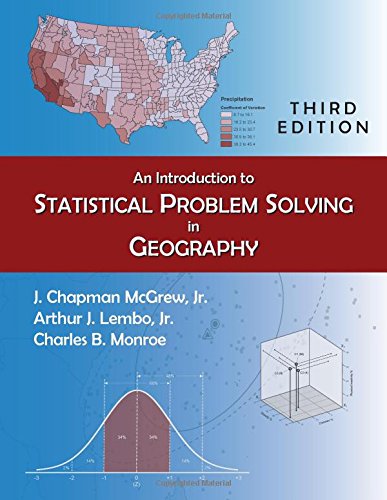

Most ebook files are in PDF format, so you can easily read them using various software such as Foxit Reader or directly on the Google Chrome browser.
Some ebook files are released by publishers in other formats such as .awz, .mobi, .epub, .fb2, etc. You may need to install specific software to read these formats on mobile/PC, such as Calibre.
Please read the tutorial at this link. https://ebooknice.com/page/post?id=faq
We offer FREE conversion to the popular formats you request; however, this may take some time. Therefore, right after payment, please email us, and we will try to provide the service as quickly as possible.
For some exceptional file formats or broken links (if any), please refrain from opening any disputes. Instead, email us first, and we will try to assist within a maximum of 6 hours.
EbookNice Team

Status:
Available5.0
37 reviews
ISBN 10: 1478611197
ISBN 13: 978-1478611196
Author: Charles B. Monroe, . Chapman McGrew Jr., Arthur J. Lembo Jr.
Now in its third edition, this highly regarded text has firmly established itself as the definitive introduction to geographical statistics. Assuming no reader background in statistics, the authors lay out the proper role of statistical analysis and methods in human and physical geography. They delve into the calculation of descriptive summaries and graphics, the use of inferential statistics as exploratory and descriptive tools, ANOVA and Kruskal-Wallis tests and different spatial statistics to explore geographic patterns, inferential spatial statistics, and spatial autocorrelation and variograms.
The authors maintain an exploratory and investigative approach throughout, providing readers with real-world geographic issues and more than 50 map examples. Concepts are explained clearly and narratively without oversimplification. Each chapter concludes with a list of major goals and objectives. An epilogue offers over 150 geographic situations, inviting students to apply their new statistical skills to solve problems currently affecting our world. The accompanying CD provides data sets for many of the book's examples, appropriate for use with a variety of statistical and GIS software.
PART I – Basic Statistical Concepts in Geography
Chapter 1: Introduction – The Context of Statistical Techniques
1.1 The Role of Statistics in Geography
1.2 Examples of Statistical Problem Solving in Geography
Chapter 2: Geographic Data – Characteristics and Preparation
2.1 Selected Dimensions of Geographic Data
2.2 Levels of Measurement
2.3 Measurement Concepts
2.4 Basic Classification Methods
PART II – Descriptive Problem Solving in Geography
Chapter 3: Descriptive Statistics and Graphics
3.1 Measures of Central Tendency
3.2 Measures of Dispersion and Variability
3.3 Measures of Shape or Relative Position
3.4 Selected Issues: Spatial Data and Descriptive Statistics
Chapter 4: Descriptive Spatial Statistics
4.1 Spatial Measures of Central Tendency
4.2 Spatial Measures of Dispersion
PART III – The Transition to Inferential Problem Solving
Chapter 5: Basics of Probability and Discrete Probability Distributions
5.1 Basic Probability Processes, Terms, and Concepts
5.2 The Binomial Distribution
5.3 The Geometric Distribution
5.4 The Poisson Distribution
Chapter 6: Continuous Probability Distributions and Probability Mapping
6.1 The Normal Distribution
6.2 Probability Mapping
Chapter 7: Basic Elements of Sampling
7.1 Sampling Concepts
7.2 Types of Probability Sampling
7.3 Spatial Sampling
Chapter 8: Estimation in Sampling
8.1 Basic Concepts in Estimation
8.2 Confidence Intervals and Estimation
8.3 Geographic Examples of Confidence Interval Estimation
8.4 Sample Size Selection
PART IV – Inferential Problem Solving in Geography
Chapter 9: Elements of Inferential Statistics
9.1 Terms and Concepts in Hypothesis Testing: One-Sample Difference of Means Test
9.2 One-Sample Difference of Proportions Test
9.3 Selected Issues in Inferential Testing
Chapter 10: Two-Sample and Dependent-Sample (Matched-Pairs) Difference Tests
10.1 Two-sample Difference of Means Tests
10.2 Two-sample Difference of Proportions Test
10.3 Dependent-sample (Matched-Pairs) Difference Tests
Chapter 11: Three-or-More-Sample Difference Tests – Analysis of Variance Methods
11.1 Analysis of Variance (ANOVA)
11.2 Kruskal-Wallis Test
11.3 Example Applications in Geography
Chapter 12: Categorical Difference Tests
12.1 Goodness-of-Fit Tests
12.2 Contingency Table Analysis
PART V – Inferential Spatial Statistics
Chapter 13: General Issues in Inferential Spatial Statistics
13.1 Types of Spatial Pattern
13.2 The Concept of Autocorrelation
13.3 Who is My Neighbor?
Chapter 14: Point Pattern Analysis
14.1 Nearest Neighbor Analysis
14.2 Quadratic Analysis
Chapter 15: Area Pattern Analysis
15.1 Join Count Analysis
15.2 Moran’s I Index (Global)
15.3 Moran’s I Index (Local)
PART VI – Statistical Relationships Between Variables
Chapter 16: Correlation
16.1 The Nature of Correlation
16.2 Association of Interval-Ratio Variables
16.3 Association of Ordinal Variables
Chapter 17: Simple Linear Regression
17.1 Form of Relationship in Simple Linear Regression
17.2 Strength of Relationship in Simple Linear Regression
17.3 Residual or Error Analysis in Simple Linear Regression
17.4 Inferential Use of Regression
17.5 Example: Simple Linear Regression – Lake Effect Snow in Northeastern Ohio
Chapter 18: Examples of Multivariate Problem-Solving in Geography
18.1 The Basics of Multiple Regression
18.2 The Basics of Cluster Analysis
PART VII – Epilogue
Chapter 19: Problem Solving and Policy Determination in Practical Geographic Situations
19.1 Geographic Problem Solving and Policy Situations
19.2 Answers to Geographic Problems and Policy Situations
Appendix: Statistical Tables
Index
an introduction to statistical problem
an introduction to statistical problem solving in geography 4th edition
an introduction to statistical problem solving in geography fourth edition
an introduction to statistical problem solving in geography third edition
introduction to statistical analysis
Tags: Charles Monroe, Chapman McGrew, Arthur Lembo, An Introduction, Statistical Problem